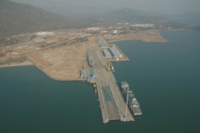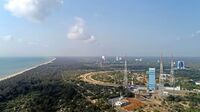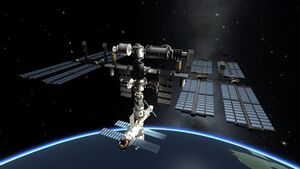Çakar Space Exploration Agency
| Çakar Space Exploration Agency साकर अंतरिक्ष अन्वेषण एजेंसी | |
 | |
| Abbreviation | ÇSEA |
|---|---|
| Predecessor |
Corian Space Agency (1648 AN - (1661 AN Kraskosmos (1650 AN - (1661 AN Krasnocorian Kosmos Agency (1661 AN - 1688 AN) formally Salafuabad Space Centre (1688 AN - 1719 AN) |
| Formation | 1719 AN |
| Type | National agency |
| Purpose/focus | Space exploration |
| Headquarters | Agra, Çakaristan |
| Region served | National |
| Official languages | Common Tongue |
| Budget | classified |
The Çakar Space Exploration Agency (ÇSEA) is the national space agency of Çakaristan. It is headquartered in Agra.
ÇSEA is primarily responsible for performing tasks related to space-based operations, space exploration, international space cooperation and the development of related technologies.
History
The predecessors of Krasnocoria, Coria and Krasnarus, each had their own space programme. In 1661 AN, the respective space agencies formed the Krasnocorian Kosmos Agency. Six satellites were launched from Slavograd Cosmodrome. Between 1675 and 1679, six astronauts were sent to the Orbital Command.
In 1719 AN, the Salafuabad Space Centre was transformed into Çakar Space Exploration Agency. After dissolution of the Collective Security Association, the space assets came under Çakari flag. In addition, the need to have a space programme had been around for some time. Four years later, the first satellite was launched.
Orbital Command
After the fall of Krasnocoria, the Common Cosmos Colonization Coalition, the space agency of the USSO, worked with the Çakari-flagged Salafuabad Space Centre to operate the satellites. Finally, the last satellite was deorbited in 1715 AN. Only Orbital Command was continued. Both during the period of the Great Apollonian Empire, and after the transition from the Union of States around the Sovereign Oceans to the Collective Security Association, Kildarian participation was considered.
Project Vatakan
In 1731 AN, the Chimera Class Aerial Warship was acquired, initiating research into spacecraft development. This was brought under the ‘Project Vatakan’ in 1732. The area around the former Vatakan is known as Area V. This area has been a closed military area since annexation, with technologies discovered being investigated. Besides the Chimera Class Aerial Warship, research is being done on the Aeon C7 Bomber, CJ-11 Jet Fighter, Lotus-7 Piscine, Lotus-8 Gale and Lotus-11 Krov.
Facilities
ÇSEA has the following facilities:
| Name | Location | Type | Photo | Notes |
|---|---|---|---|---|
| Batakhshahar | Ground Station | |||
| Bell Rock Spaceport | Ground Station Launching platform |

|
||
| Mayurqa | Ground Station | |||
| Salafuabad Space Centre | Ground Station Launching platform |

|
Formerly Slavograd Cosmodrome | |
| Suryapur Control Centre | Control Centre Ground Station Launching platform |
|||
| Taka'atui Space Centre | Ground Station Launching platform |

|
